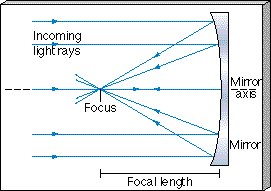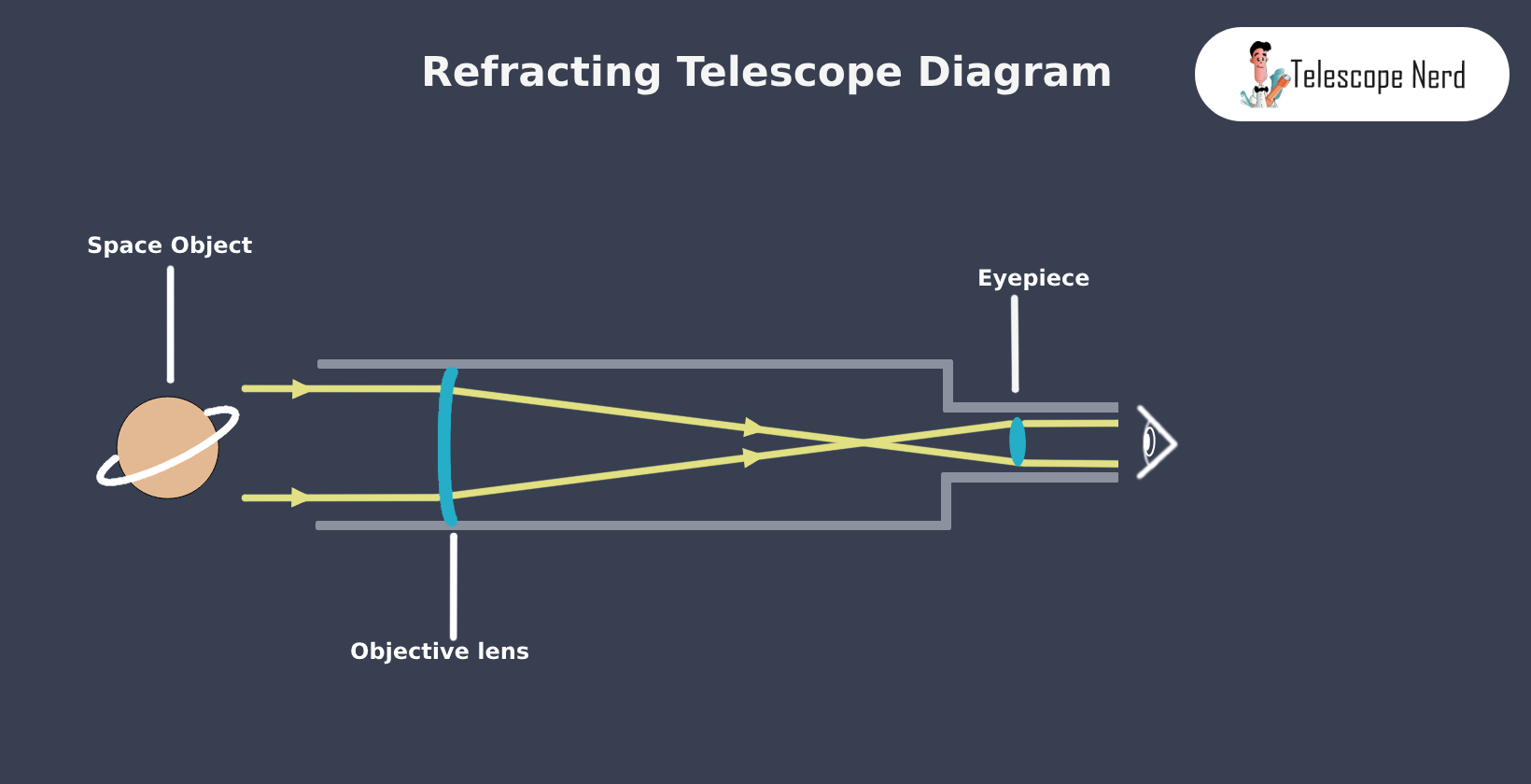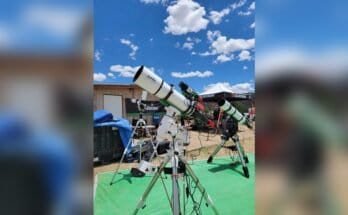Are you struggling to get a clear view through your refracting telescope? Focusing it just right can make all the difference between a blurry image and a breathtaking glimpse of the stars.
In this guide, you’ll learn simple, step-by-step tips to sharpen your telescope’s focus quickly and easily. Whether you’re a beginner or just need a refresher, mastering this skill will unlock the true beauty of the night sky for you. Keep reading, and soon you’ll be enjoying crystal-clear views like never before!

Choose The Right Location
Choosing the right location is key to focusing a refracting telescope well. A good spot helps you see clear and sharp images in the sky. Picking the best place makes your viewing easier and more enjoyable.
Find A Stable Surface
Set your telescope on a flat, steady surface. Avoid spots that shake or move easily. A stable base stops blurry images caused by shaking. Use a tripod or solid table for the best support.
Avoid Light Pollution
Light pollution makes it hard to see stars and planets. Stay away from city lights and bright street lamps. Choose dark areas with little or no artificial light. This improves the telescope’s focus and view.
Consider Weather Conditions
Clear skies help your telescope focus better. Clouds, fog, or rain block the view. Wind can shake your telescope and blur images. Pick calm, clear nights for the best results.
Set Up The Telescope
Setting up your refracting telescope is the first step to clear and sharp views. It helps you focus on distant objects with ease. Follow these simple steps to get your telescope ready for use.
Assemble The Parts
Start by taking all the telescope parts out of the box. Attach the optical tube to the mount carefully. Secure the tube with screws or clamps. Make sure everything fits tightly. Loose parts can cause shaky images.
Adjust The Mount
Place the mount on a flat, stable surface. Check that it is level using a small spirit level. Adjust the tripod legs if needed. Tighten all knobs to hold the mount steady. A steady mount helps keep the telescope still while viewing.
Align The Finderscope
Look through the main telescope and find a distant object. Point the telescope at that object. Now, adjust the finderscope so it points at the same object. Use the small screws on the finderscope to move it. This makes aiming easier and faster.
Initial Focusing Steps
Starting with the initial focusing steps helps you see clear images through your refracting telescope. These steps prepare your eyes and telescope for the best view. Simple actions can make a big difference in your viewing experience.
Select A Bright Object
Pick a bright object in the sky or on the ground. The Moon, a bright star, or a distant streetlight works well. Bright objects are easier to focus on and help you adjust quickly.
Use Low Power Eyepiece
Attach the low power eyepiece to your telescope first. It gives a wider view and makes finding objects easier. Start with low power to avoid confusion and get a clear initial image.
Adjust The Focusing Knob
Slowly turn the focusing knob until the object looks sharp. Small movements help you find the perfect focus. Stop when the object’s edges look clear and details are visible.

Fine-tune For Sharpness
Fine-tuning your refracting telescope is crucial for clear and sharp images. It helps bring distant objects into perfect view. Small adjustments make a big difference in what you see. This step improves the focus beyond the basic setup.
Focus changes are subtle and need patience. Taking time here enhances your entire viewing experience. Let’s explore how to fine-tune your telescope for the best sharpness.
Switch To High Power Eyepiece
Start by changing to a high power eyepiece. This eyepiece zooms in more on your target. It makes small focus errors easier to notice. Using high magnification reveals details that low power hides.
Make Small Focus Adjustments
Turn the focus knob slowly and in small steps. Focus moves should be gentle and precise. Stop when the image starts to sharpen. Avoid quick or large turns that can miss the perfect focus.
Check For Image Clarity
Look closely at the image after each adjustment. The goal is clear edges and fine details. Blurry or fuzzy images mean more tuning is needed. Keep adjusting until the image looks crisp and sharp.
Troubleshoot Common Issues
Using a refracting telescope can be fun, but sometimes issues arise. These problems can stop you from seeing clear images or finding objects in the sky. Knowing how to fix common problems helps you enjoy your telescope more. Below are common issues and simple ways to solve them.
Blurred Or Double Images
Blurred or double images happen if lenses are dirty or out of alignment. Clean the lenses gently with a soft cloth. Check if the eyepiece is correctly placed and tightened. Make small adjustments to the focus knob until the image sharpens. Avoid pressing too hard on the telescope to keep lenses aligned.
Difficulty Finding Objects
Finding objects can be hard if the telescope is not pointed correctly. Use a finder scope to help aim the telescope. Start with a low-power eyepiece to see a wider view. Make sure the telescope is steady and level. Take time to learn how the telescope moves to make aiming easier.
Telescope Not Holding Focus
A telescope that does not hold focus may have loose parts. Tighten the focus knob and the eyepiece holder carefully. Check for any worn or broken parts inside the focuser. Sometimes temperature changes cause focus to shift; allow the telescope to adjust to outdoor temperatures before use.

Maintain Your Telescope
Maintaining your refracting telescope keeps it working well for years. A clean, well-stored, and properly aligned telescope gives the best view of the night sky. Regular care helps avoid blurry images and focusing problems. Follow simple steps to keep your telescope in top shape.
Clean The Lenses Properly
Use a soft brush to remove dust gently. Avoid touching the glass with fingers. Use lens cleaning solution and a microfiber cloth for smudges. Clean only when necessary to avoid scratches. Always clean in a circular motion for the best results.
Store In A Safe Place
Keep your telescope in a dry, dust-free area. Use a padded case or cover to protect it. Avoid places with high humidity or extreme temperatures. Store it away from direct sunlight to prevent damage. Proper storage prevents dirt buildup and mechanical issues.
Regularly Check Alignments
Check the alignment of lenses and finders often. Misaligned parts cause blurry images and hard focusing. Use the manual or online guides for alignment steps. Make small adjustments carefully for clear views. Regular checks ensure a sharp, focused telescope experience.
Frequently Asked Questions
How Do I Focus A Refracting Telescope Properly?
To focus a refracting telescope, start by pointing it at a distant object. Slowly turn the focuser knob until the image becomes sharp and clear. Avoid moving the telescope while focusing to maintain stability and precision.
Why Is My Refracting Telescope Image Blurry?
A blurry image usually means the telescope is out of focus. Check the focuser and adjust it slowly. Also, ensure lenses are clean and aligned properly to avoid distortion.
When Should I Adjust The Focus On My Refracting Telescope?
Adjust focus whenever you change targets or eyepieces. Atmospheric conditions can also affect clarity, so refocus as needed for the sharpest view.
Can I Use A Refracting Telescope Without Focusing?
No, focusing is essential to see clear, sharp images. Without it, objects will appear blurry and details will be lost.
Conclusion
Focusing a refracting telescope takes patience and practice. Start by adjusting the focus slowly until the image is clear. Use a bright object like the moon or a distant building. Small movements make a big difference. Keep your hands steady and avoid shaking the telescope.
Clear images help you enjoy your viewing experience better. Remember, each telescope may feel a bit different. Take your time and enjoy the process. Soon, focusing will become easy and natural. Happy stargazing!



